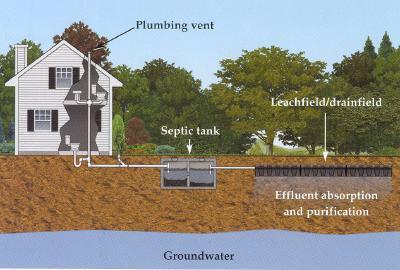4 Tips to Keep Your Septic System From Failing
 You wouldn’t skip routine maintenance on an expensive car. Nor should you ignore the upkeep on your septic system. Keep in mind that a septic system costs less than $400 to pump but $12,000 or more to replace and can affect the resale of your property.
You wouldn’t skip routine maintenance on an expensive car. Nor should you ignore the upkeep on your septic system. Keep in mind that a septic system costs less than $400 to pump but $12,000 or more to replace and can affect the resale of your property.
On Lake Winona, failing septic systems have a huge impact on lake water quality. In fact, they account for 5-10% of the phosphorus that reaches lakes. Increased phosphorus destroys the health a fresh water body, as it encourages algae in the water to grow faster than would naturally occur, turning clear lakes green and cloudy.
Here are four tips to keep your septic system working properly:
1. Control What Goes In
Maybe you’ve heard that some materials help septic systems and some harm them. Here’s the truth about what’s good and what’s bad to put down the drain.
- Too much water—from any source—can overload your system. Install water-saving toilets and appliances, or at least fix toilet leaks and pace out laundry loads. A houseful of guests can also stress the system, so ask them to avoid long showers and full-throttle faucet flows.
- Too many solids are bad, too; they pile up as sludge in your septic tank. If you have a garbage disposal, use it only to clean out the fine scraps that collect in a drain strainer. Otherwise, you could need to have the tank pumped every year or two.
- Fats turn to scum in a septic tank. Instead of dumping them down a drain, skim off grease or let it solidify in the refrigerator, then toss into garbage. Also consider a compost pile or composting drum for organic food waste.
- Phosphates from cleaning products get into the lake water. The drainfield that accompanies your septic system works by absorbing and filtering the water from your septic tank, including any chemicals in your water. For homes near lakes, these chemicals get into the lake water either through the ground itself or through storm run off. Phosphorus, generally in the form of phosphates, is a popular ingredient in detergents, soap and personal care products poses significant problems for adjacent waterbodies. Replace your products with phosphate-free alternatives.
- Chlorine bleach and drain cleaner kill the beneficial bacteria in septic tanks making them nonfunctional. One study found that it only took about a teaspoon of chemical drain cleaner to kill the beneficial bacteria in a septic tank. Replace these chemicals with septic safe cleaning products.
- In some situations, salty discharge released by water softeners can wreak havoc on a septic system. If the person who pumps your tank notices that the scum layer doesn’t appear normal, protect your septic system by eliminating their use or switching to salt-free water softener (about $1,000 or more).
2. Protect the Parts
Check the records that came with your house to find out where all of the components of your system are located, so you or your visitors don’t inadvertently ruin them. Never drive over the drainfield. Besides possibly cracking a pipe, the weight of a vehicle compacts the soil and makes it less able to absorb water.
Keep shrubs and trees well away from both the septic tank and the drainfield. Their roots can snake into pipes and clog them. But you should encourage grass on the drainfield because it absorbs water and prevents erosion—without digging its roots into the pipes.
3. Pump Periodically
With a standard system, call for a pump truck on a regular schedule (typically every three to five years). If you’re careful about what goes down your drains, you might be able to go longer between service calls, so ask your pumper for advice.
Don’t waste your money on additives that claim to break down sludge in the tank and therefore prolong the time between pump-outs. Pump regularly instead. Some additives do nothing and others have bad side effects, such as loosening the scum in the tank so that it then clogs the drainfield.
Pumping costs $200 to $400, if the lid is easily accessible. If it’s buried, you might pay another $100 unless you excavate it yourself. When the tank is empty, have it checked for leaks and have them fixed promptly. Also, ask about the condition of the baffles, which keep scum out of the inlet and outlet. If they’re missing or deteriorated, replace them.
4. Conduct Your Own Inspections
Walk across your drainfield during the rainy season. If you smell sewage or find that grass is growing especially fast and lush in one area, your drainfield could be clogging. Call in a septic repair company for advice.